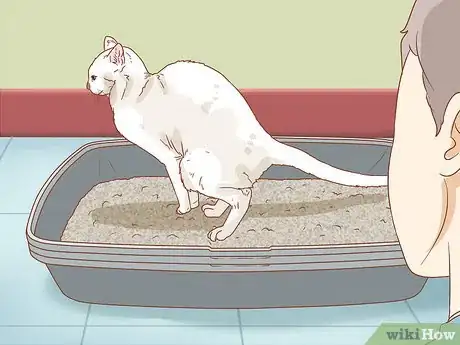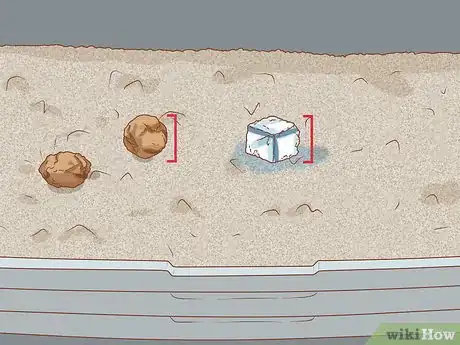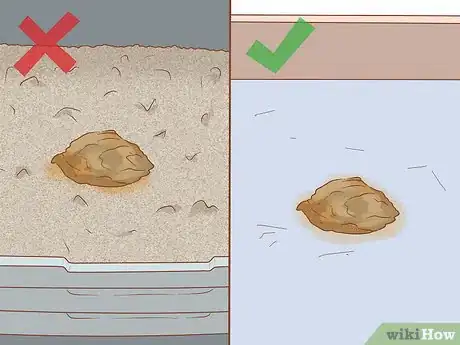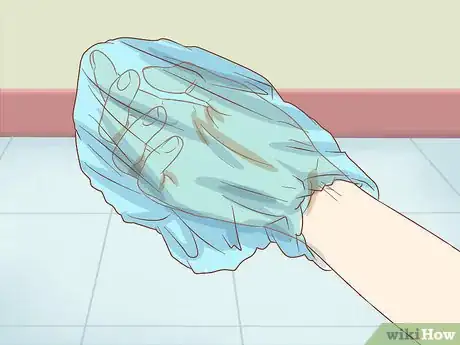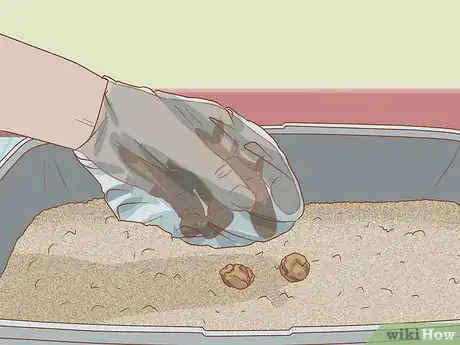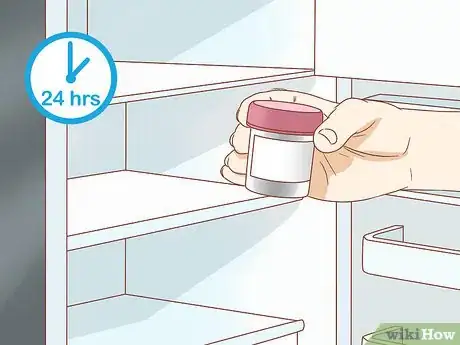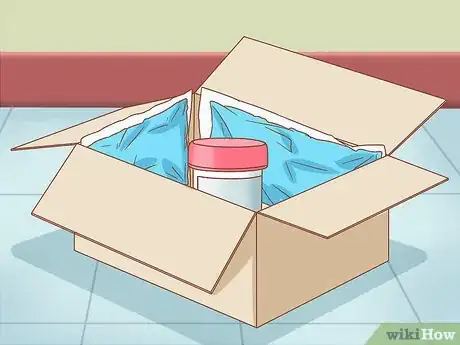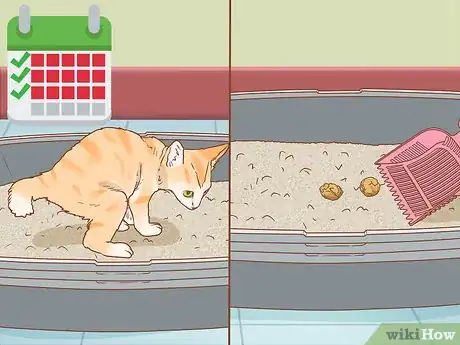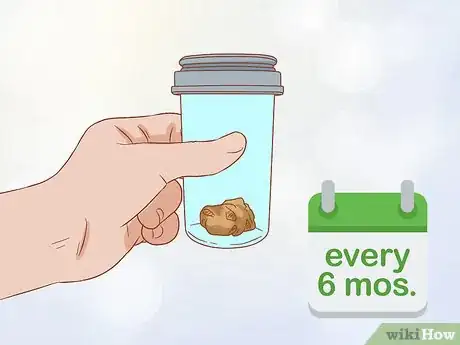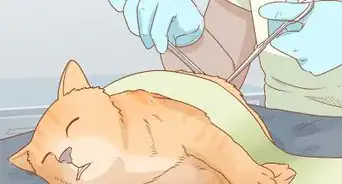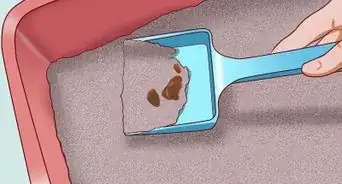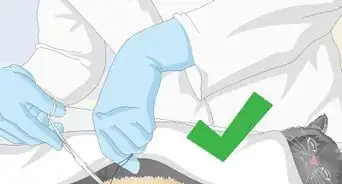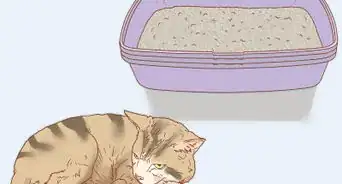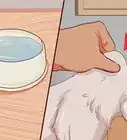This article was co-authored by Pippa Elliott, MRCVS. Dr. Elliott, BVMS, MRCVS is a veterinarian with over 30 years of experience in veterinary surgery and companion animal practice. She graduated from the University of Glasgow in 1987 with a degree in veterinary medicine and surgery. She has worked at the same animal clinic in her hometown for over 20 years.
This article has been viewed 91,609 times.
Fecal samples are a necessity to check cats for parasites and keep them healthy. Your veterinarian may request that you collect a fecal sample if your cat has been sick or as part of a routine exam. By testing fecal samples regularly, your veterinarian can identify and treat parasites before they get worse.
Steps
Choosing and Obtaining the Sample
-
1Make sure that the sample is moist and fresh. Keep an eye on your cat and collect the sample soon after they defecate. If the sample is dried out, then it is likely old. Wait until you can collect a sample that is still moist. This will yield the most accurate results from your cat’s stool sample test.[1]
- The sample will also look shiny if it is fresh. If it looks white or has a matte finish, then it is likely old.
Tip: If you have multiple cats using the same box, place the cat into a room alone with a litter box, food, and water until it defecates. This will ensure that the sample you get is from that cat.
-
2Select a sample that is about the size of a sugar cube. This is an adequate amount for your veterinarian to run tests for parasites on the stool sample. If the sample is smaller than this, then wait until your cat defecates again to collect the sample.[2]
- It’s okay if you have more stool than this, just do not submit less or they may not be able to run tests on it.
Advertisement -
3Ensure that the sample is as free from debris as possible. Having a bit of cat litter on the sample is usually okay as long as your cat has normal stool. However, if your cat is having diarrhea or loose stools, then you will need to get a sample that is free from these contaminants. Watch to see if the cat defecates on the floor or outside.[3]
- Try removing the litter from your cat’s box until you collect the sample.
-
4Cover your hand with an inverted plastic bag when you collect the sample. Turn a plastic bag inside out and place it over your hand like a glove. This will protect your hand and you can also use the bag as a collection device.[4]
- Another option is to wear a glove and use the gloved hand to place the sample into a plastic bag or collection cup.
-
5Grasp the feces with your plastic-covered fingers. After you have the feces in your plastic-covered hand, use your other hand to turn the bag right side out. Be careful not to let the fecal sample fall out or touch the opening of the bag. Then, press along the zippered part to close the plastic bag.[5]
- You can also use a feces collection bag that ties on the top. Collect the sample the same way, but then tie the ends of the bag in a knot after you turn it right side out.
- The other option is to place the sample into a clean plastic container with a tight-fitting lid. Do not use glass, an old medication bottle, or a paper towel to collect the sample as these may contaminate it.
Tip: Check with your vet to see if you need to collect 3 samples in the same container over the course of 3 days, otherwise known as a pooled sample. This helps detect parasites that are shed intermittently.
Storing and Submitting the Sample
-
1Try to submit the sample to your veterinarian within 6 hours. A fresh stool sample less than 6 hours old is essential for diagnostic purposes. The fresher the stool sample, the more accurate the test results will be! Otherwise, the organisms in the stool may have died and the test may end up as a false negative.[6]
- If you are taking your cat for a checkup, bring the sample along when you take them. Try to collect the sample the morning of your cat’s appointment.
-
2Store the sample in your refrigerator for no more than 24 hours. If you cannot get the sample to the vet within 6 hours, put it into the refrigerator right away and store it for up to 24 hours until you can submit it. After you have placed the sample into a plastic bag or container, put that container or bag inside of another resealable bag. Then, place the sample into a bottom shelf of your refrigerator away from food.[7]
- Make sure to tell other members of your household what is in the bag so that they do not disturb it or try to investigate!
- Never freeze the sample or keep it in a hot area! This will invalidate any tests for parasites since the extreme temperature will kill the organism.[8]
Tip: Do not store the sample in a container that you would like to use again! You will need to throw the container away after using it to store your cat’s feces.
-
3Mail the sample with an ice pack if you need to send it to a lab. If you have to send the stool sample to a lab via mail, then make sure to place an ice pack into the box with the sample. This will help to ensure that the sample stays cool and does not get overheated in transit, which would make the sample unusable.[9]
- Place an extra bag around the ice pack and surround the bag and sample with paper towels to absorb any moisture in the package.
Determining if Your Cat Needs Its Stool Tested
-
1Collect a sample from kittens every 2 to 3 weeks for up to 20 weeks. Kittens are especially susceptible to parasites, so they require more frequent stool tests. Collect and bring in a stool sample for any kittens you have the first time you take them to the vet and then any time your vet requests follow-up samples.[10]
-
2Submit a sample for your adult cat once every 6 months. Your veterinarian will usually ask you to submit a stool sample whenever your cat goes in for a vaccination or checkup. This is an important measure to check your cat for parasites and treat them before they get out of hand.[11]
- You may not need to submit samples as often if your cat stays indoors. Outdoor cats are more susceptible to parasites.
-
3Request a stool test if your cat has unusual bowel movements. Call your vet and let them know if your cat is having loose stools, or if there is blood or mucus in their stools. Check your cat’s litter box once per week to make sure it is having normal stools and call your veterinarian if you notice anything abnormal.
- Certain conditions cause one or more of these issues, such as trichomonas. This is a serious parasitic infection that requires treatment, so it is important to rule this out.[12]
Wondering what might be causing your cat’s diarrhea? You can look into possible reasons why they might be having diarrhea and take action to treat it.
Things You’ll Need
- Fecal sample collection kit or plastic container or resealable plastic bag
- Plastic spoon
- Ice pack (optional for mailing)
References
- ↑ https://www.smithsstationah.com/stool-sample-collection.pml
- ↑ https://www.smithsstationah.com/stool-sample-collection.pml
- ↑ https://www.webvets.com/Resources/resource.php?Fecal-Sample-Collection-Guide-117
- ↑ https://www.smithsstationah.com/stool-sample-collection.pml
- ↑ https://www.smithsstationah.com/stool-sample-collection.pml
- ↑ https://www.webvets.com/Resources/resource.php?Fecal-Sample-Collection-Guide-117
- ↑ https://www.webvets.com/Resources/resource.php?Fecal-Sample-Collection-Guide-117
- ↑ https://winslowanimalhospital.com/5-tips-on-bringing-your-pets-stool-sample-to-us-winslow-animal-hospital-dog-cat/
- ↑ http://vetmed.tamu.edu/gilab/service/assays/tritrichomonas
About This Article
To collect fecal samples from a cat, wait for your cat to defecate so the sample is moist and fresh. If your cat has diarrhea, wait until it passes a firm stool before collecting your sample. Next, turn a sealable plastic baggie inside out and place it over your hand like a glove. Then, gently grab the feces with your protected fingers. Be sure to get a sample that's about the size of a sugar cube! Finally, use your other hand to turn the baggie right side out and seal it closed. For tips on properly storing and submitting the sample, read on!
